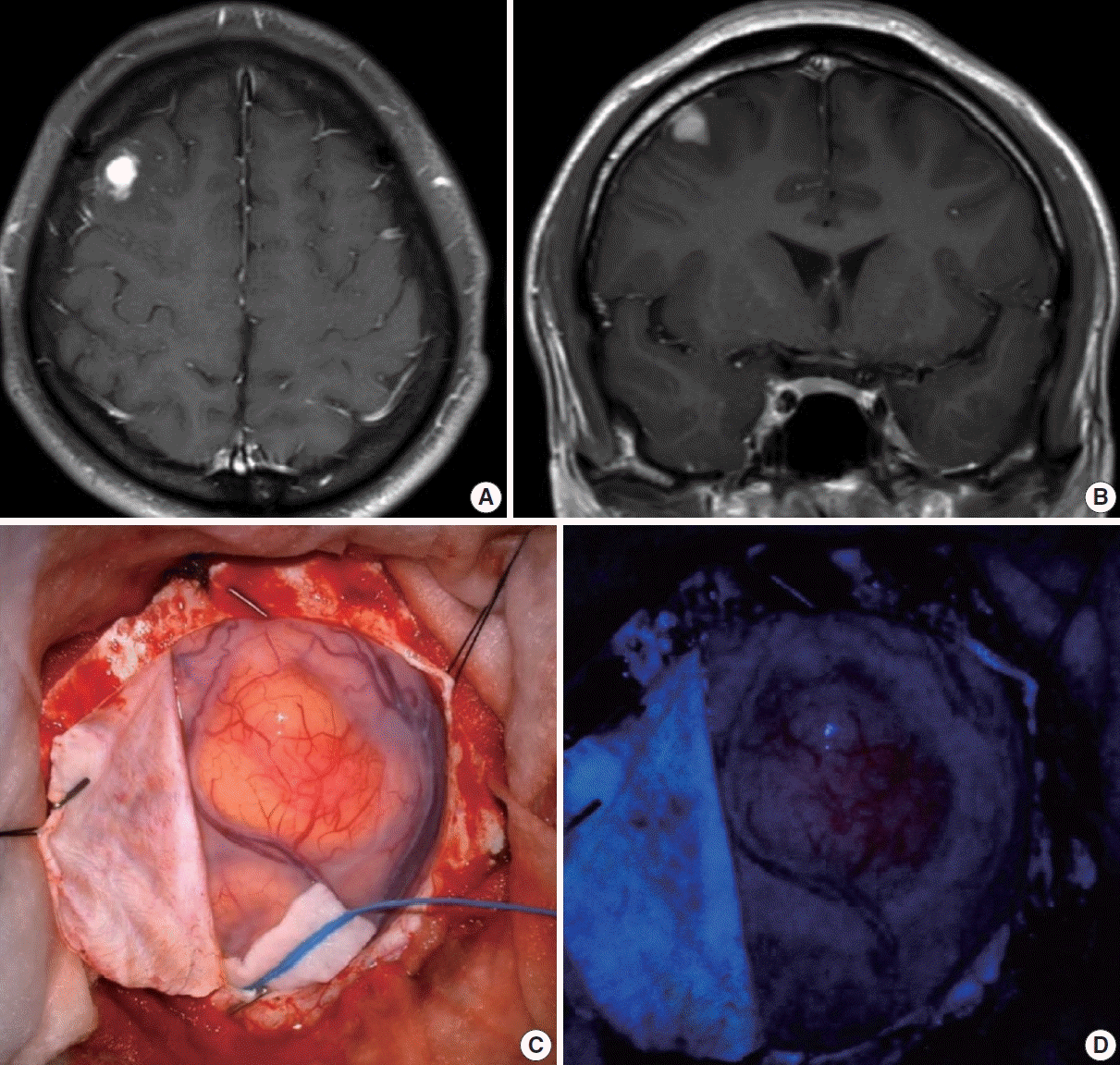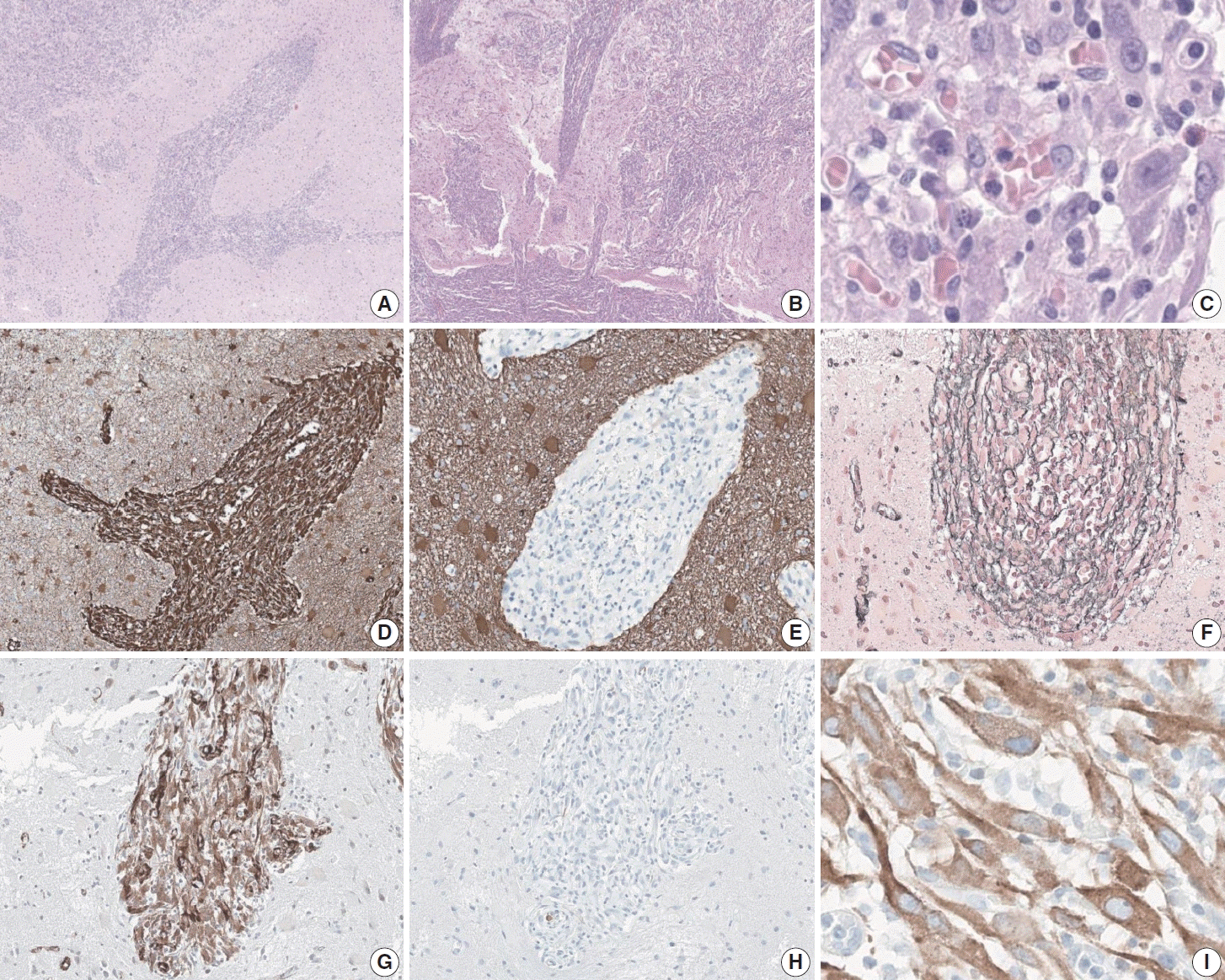Epithelioid inflammatory myofibroblastic sarcoma (EIMS) is an aggressive subtype of inflammatory myofibroblastic tumor (IMT) with a predominant intra-abdomen localization, followed by pulmonary localizations. EIMS is a histologically distinct subtype of IMT and clinically more aggressive [
1]. Taken together, less than 100 cases of primary IMT/EIMS arising from sites other than the intra-abdomen and pulmonary sites have been reported, with the fewest known to arise in the central nervous system (CNS). While primary IMT in the CNS is itself rare, due to its mostly extra-axial presentation, it is usually included in the differential diagnosis for meningioma [
2,
3]. Primary EIMS of the CNS is even rarer, having only been reported once [
4]. The first reported case of primary EIMS of the CNS harbored a
VCL::ALK fusion [
4]. Herein, we describe the second case of primary EIMS of the brain with an
EML4::ALK fusion to characterize this rare entity for the diagnostic benefit of neuropathologists and general pathologists alike, as well as for clinicians and radiologists, as the tumor presented intra-axially, mimicking a glioma.
CASE REPORT
A 22-year-old male soldier was found lethargic, drooling, and breathing heavily in the middle of the night. His eyes showed upward deviation, and after a brief seizure episode, he regained consciousness in the ambulance. Emergency electroencephalogram was normal, but the emergency computed tomography revealed a mass in the right frontal lobe. A subsequent preoperative contrast-enhanced magnetic resonance imaging (MRI) glioma study (3.0T) revealed a 1.5× 1.4× 0.9 cm vividly enhancing mass with focal diffusion restriction and no intralesional hemorrhage or calcification (
Fig. 1A, B). A craniotomy and tumor removal was done by the neurosurgical team at Seoul National University Hospital (SNUH), who noted intraoperatively that the tumor appeared grossly more yellow-orange than the surrounding parenchyma with no attachment to dura, and showed a 5-aminolevulinic acid (5-ALA) uptake (
Fig. 1C, D).
Microscopic examination demonstrated an infiltrative epithelioid spindle neoplasm that seemed to spread in a perivascular pattern at low power (
Fig. 2A). The low-power view also illustrated the appearance of the tumor to extend from the pia mater into the brain parenchyma (
Fig. 2B). Even at high-power view, perivascular growth of the tumor can be appreciated, along with a lymphoplasmacytic infiltrate in the stroma and large nuclei with apparent nucleoli (
Fig. 2C). The immunophenotype of the tumor is positive for vimentin, reticulin, and smooth muscle actin, while negative for glial fibrillary acidic protein and desmin (
Fig. 2D–H). Anaplastic lymphoma kinase (ALK) showed a characteristic perinuclear staining for both the 5A4 clone (
Fig. 2I) and the D5F3 clone (data not shown). In addition, the tumor cells were positive for alpha-thalassemia/intellectual disability syndrome X-linked, H3K27 trimethylation (H3K27me3), c-Myb, methylthioadenosine phosphorylase, while negative for isocitrate dehydrogenase 1, CD34, neuronal nuclear antigen, synaptophysin, microtubule associated protein-2, and Olig2. The tumor was negative for BRAF staining and also showed focal positivity to epithelial membrane antigen. The FiRST Brain Tumor Panel v3.3, which is a customized next-generation sequencing (NGS) panel developed at SNUH, was performed on the patient’s tumor to reveal an
EML4::ALK fusion. Mitotic activity was 3 per 2 mm 2 as measured with phospho-histone H3 immunohistochemistry, and the Ki-67 proliferative index was 6.6%.
The diagnosis of EIMS was rendered. An F-18 fluorodeoxyglucose positron emission tomography revealed no abnormal hypermetabolic lesions in the brain or the scanned body, helping to rule out the possibility of brain metastasis and confirming that the EIMS was indeed primary to the brain. Following the radiologic confirmation of the gross total resection of the tumor, the patient received adjuvant intensity-modulated radiation therapy at 60 Gy and 30 fractions for 2 months after the surgery. The patient is being followed up by the oncology team every 6 months, and by the neurology team for his anti-epileptic drug titration.
DISCUSSION
EIMS is an aggressive subtype of IMT that has been recognized by the World Health Organization (WHO) Classification of Tumors since its fifth edition publication of various organ systems, with the notable exception of
WHO Classification of Central Nervous System Tumors that does not feature either EIMS or IMT as a primary entity for their extreme rarity [
5]. As such, whenever IMT is considered as a diagnosis, regardless of the primary site, EIMS is an important differential diagnosis. The clinicoradiological presentation of the primary EIMS of the CNS is distinct from the primary IMT of the CNS, as most of the intracranial IMT reported were extra-axial, requiring a differential diagnosis of meningioma, while the intracranial EIMS in our patient appeared intra-axial, mimicking a glioma [
2,
3]. EIMS also has a distinct histopathology in the CNS, with a perivascular growth pattern that seems to extend from the pia mater, which was not noted in the case report on the first primary EIMS of the CNS [
4]. In our case, the region with less apparent perivascular growth pattern features the more epithelioid morphology with a heavier inflammatory infiltrate, while the perivascular region shows the more spindle and less inflamed features. While the first primary EIMS of the CNS was localized in the temporal horn of the left lateral ventricle of a 72-year-old patient [
4], the EIMS of our 22-year-old patient was in the right frontal lobe. Notably, both primary EIMS of the CNS were supratentorial. The age of EIMS patients in any anatomic localization varies widely, from infants as young as 7 months [
6] to a 72-year-old adult [
4], with a median age of 39 years [
1].
The immunohistochemistry for ALK showed a characteristic perinuclear staining that was noted back when EIMS was first introduced as an aggressive subtype of IMT in 2011, as was the immunophenotype with the first primary EIMS of the CNS [
1,
4]. For IMT, it is known that the ALK staining pattern can vary from nuclear to perinuclear, depending on the driving fusion identified [
1,
7]. Of the EIMS that show ALK positivity on immunohistochemistry, the patients can benefit from ALK inhibitor therapy [
8], although our patient opted for an adjuvant radiation therapy. Among the ALK-negative EIMS, ROS1 or even NTRK3 alterations can be expected [
9], with TRK fusion-positive cases especially of note, since, while rare, their identification can give even pediatric patients the option for TRK inhibitor therapy that is tissue agnostic, crosses the blood-brain barrier, and shows mild adverse effects [
10].
In our patient’s EIMS, the NGS study revealed an
EML4::ALK fusion from exon 2 and exon 20 of chromosome 2, respectively (Transcript ID–NM_019063/NM_004304). This fusion is well known in various malignancies, most famously in the non-small cell carcinomas of the lung, but also in intra-thoracic IMTs [
11,
12], and intra-abdominal EIMS [
13].
In the fourth edition of the
WHO Classification of Tumors of Soft Tissue and Bone, published in 2013, the authors of the IMT chapter suggested that the IMT behaving aggressively could be labeled “inflammatory fibrosarcoma” instead of “atypical IMT” [
14], but there are no known instances of primary inflammatory fibrosarcoma of the CNS in the literature. Therefore, not only is EIMS a relatively new entity with less than a decade of being diagnosed, but also this has led to some discrepancies in its descriptions by the WHO Classifications of Tumors, as summarized in
Table 1.
We need to include a unified sentence to the localization section for each of the WHO Classification of Tumors that lists IMT and EIMS as a chapter and try to recognize the clinical behavior of EIMS with the accumulation of more data. RANBP2::ALK and RRBP1::ALK fusions are noted specifically to EIMS in the abdominal cavity in the
WHO Classification of Female Genital Tumors [
1,
7]. As fusions can be specific to the site of origin, this mention of reported fusions should be applied separately to other organ system publications. In the case of
WHO Classification of Central Nervous System Tumors, not only should IMT/EIMS chapter be added in the next edition, it should also feature the
VCL::ALK fusion [
4] and
EML4::ALK fusion, uniquely identified in the primary EIMS of the CNS. The
WHO Classification of Breast Tumors lists IMT as a separate chapter, while noting that less than 25 cases have been reported [
15]. In contrast, 55 cases of primary IMT in the intracranium has been reported [
16]. The number of reported cases alone should therefore justify a separate chapter in the
WHO Classification of Central Nervous System Tumors, while noting that, though rare, EIMS has been reported twice to arise from the CNS.
In summary, we present the second case of EIMS primary to the CNS with EML4::ALK fusion to further elucidate the histomorphological characteristics and the immunophenotype of this rare entity. Given the atypical localization, the diagnosis of this tumor can be challenging to both neuropathologists and general pathologists alike. Recognizing the utility and limitations of ALK immunohistochemistry studies on a suspected EIMS lesion will guide pathologists to rely on NGS studies to identify fusions that will support their histomorphological diagnosis of EIMS.






 PDF
PDF Citation
Citation Print
Print



 XML Download
XML Download